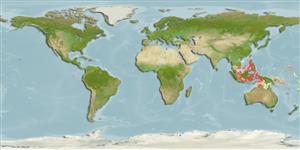>
Ovalentaria/misc (Various families in series Ovalentaria) >
Opistognathidae (Jawfishes)
Etymology: Opistognathus: Greek, opisthe = behind + Greek, gnathos = jaw (Ref. 45335); to the very elongate upper jaw of the type species of the genus, Opistognathus nigromarginatus (Ref. 128653); randalli: Named for Dr. John E. Randall.
Eponymy: Dr John ‘Jack’ Ernest Randall Jr. [...] (Ref. 128868), visit book page.
Environment: milieu / climate zone / depth range / distribution range
экология
морской; пределы глубины 5 - 32 m (Ref. 81517). Tropical
Western Pacific: Indonesia, eastern Borneo and the Philippines.
Size / Вес / Возраст
Maturity: Lm ? range ? - ? cm
Max length : 10.4 cm SL самец/пол неопределен; (Ref. 81517); 10.9 cm SL (female)
Краткое описание
определительные ключи | морфология | морфометрия
колючие лучи спинного плавника (общее число) : 11; членистые (мягкие) лучи спинного плавника (общее число) : 14 - 16; колючие лучи анального плавника: 3; членистые (мягкие) лучи анального плавника: 14 - 15; позвонки: 28. This species is distinguished by the following characters: elongate supramaxilla and posterior end of maxilla produced as a thin flexible lamina; a single conspicuous black stripe at inner lining of upper jaw and adjacent membranes; dorsal, anal and caudal fins with narrow, pale (blue in life) distal margins; when alive, dorsal portion of iris golden; lateral-line terminus below verticals between segmented dorsal-fin rays 1 to 4, typically below second to third ray; caudal vertebrae 18 (Ref. 81517).
Males of this species are strongly territorial and frequently engage in jaw locking combat, apparently to evict rivals or confiscate their burrows (Ref. 81517). Found in sand/rubble bottoms near reefs in about 5-30 m (Ref 90102).
Life cycle and mating behavior
половая зрелость | размножение | нерест | икра | Fecundity | личинки
Smith-Vaniz, W.F., 2009. Three new species of Indo-Pacific jawfishes (Opistognathus: Opistognathidae), with the posterior end of the upper jaw produced as a thin flexible lamina. aqua, Int. J. Ichthyol. 15(2):69-108. (Ref. 81517)
Статус Красного Списка МСОП (Ref. 130435: Version 2024-2)
Угроза для людей
Harmless
Использование человеком
дополнительная информация
инструменты
Специальные отчеты
Скачать в формате XML
ресурсы в Интернет
Estimates based on models
Preferred temperature (Ref.
123201): 28.4 - 29.3, mean 28.8 °C (based on 778 cells).
Phylogenetic diversity index (Ref.
82804): PD
50 = 0.5000 [Uniqueness, from 0.5 = low to 2.0 = high].
Bayesian length-weight: a=0.00389 (0.00180 - 0.00842), b=3.12 (2.94 - 3.30), in cm total length, based on all LWR estimates for this body shape (Ref.
93245).
Trophic level (Ref.
69278): 3.5 ±0.6 se; based on size and trophs of closest relatives
Fishing Vulnerability (Ref.
59153): Low vulnerability (10 of 100).
Nutrients (Ref.
124155): Calcium = 326 [174, 606] mg/100g; Iron = 1.61 [0.92, 2.70] mg/100g; Protein = 17.8 [16.7, 18.8] %; Omega3 = 0.174 [0.091, 0.341] g/100g; Selenium = 32.4 [13.1, 73.7] μg/100g; VitaminA = 46.5 [14.7, 144.0] μg/100g; Zinc = 2.27 [1.56, 3.22] mg/100g (wet weight);
